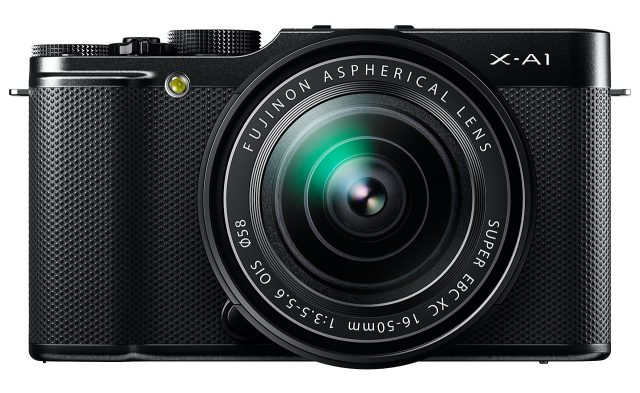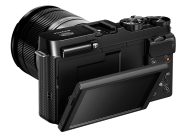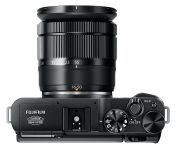Announced
Production status
System
Fujifilm X system cameras
- Fujifilm X-A1
- Fujifilm X-A10
- Fujifilm X-A2
- Fujifilm X-A20
- Fujifilm X-A3
- Fujifilm X-A5
- Fujifilm X-A7
- Fujifilm X-E1
- Fujifilm X-E2
- Fujifilm X-E2S
- Fujifilm X-E3
- Fujifilm X-E4
- Fujifilm X-H1
- Fujifilm X-H2
- Fujifilm X-H2S
- Fujifilm X-M1
- Fujifilm X-Pro1
- Fujifilm X-Pro2
- Fujifilm X-Pro2 Graphite Edition
- Fujifilm X-Pro3
- Fujifilm X-S10
- Fujifilm X-S20
- Fujifilm X-T1
- Fujifilm X-T1 Graphite Silver Edition
- Fujifilm X-T10
- Fujifilm X-T100
- Fujifilm X-T2
- Fujifilm X-T2 Graphite Silver Edition
- Fujifilm X-T20
- Fujifilm X-T200
- Fujifilm X-T3
- Fujifilm X-T30
- Fujifilm X-T30 II
- Fujifilm X-T4
- Fujifilm X-T5
- Fujifilm X-T50
Fujifilm X-A1
APS-C AF digital mirrorless camera • Discontinued
Specification
| Format: | |
| APS-C | |
Imaging sensor: | 23.6 × 15.6mm CMOS sensor |
Resolution: | 4896 × 3264 - 16 MP |
Crop factor: | 1.53x |
Sensor-shift image stabilization: | - |
| Fujifilm X [17.7mm] | |
| Shutter: | |
Type: | Focal-plane |
Model: | Electronically controlled |
Speeds: | 30 - 1/4000 + B |
| Exposure: | |
Exposure metering: | Through-the-lens (TTL), open-aperture |
Exposure modes: | Programmed Auto |
| Aperture-priority Auto | |
| Shutter-priority Auto | |
| Manual | |
| Physical characteristics: | |
Weight: | 330g |
Dimensions: | 116.9x66.5x39mm |
Manufacturer description
Valhalla, N.Y., September 17, 2013 – FUJIFILM North America Corporation today announced the new FUJIFILM X-A1 compact system camera (CSC), the fourth interchangeable lens system camera introduced within the award-winning FUJIFILM X-Series. The ultra-light X-A1 gives consumers an affordable entry point into the X-Series line of digital cameras and delivers outstanding image quality using its large 16.3 Megapixel APS-C CMOS sensor, easy operation and wireless image transfer for quick photo sharing.
The FUJIFILM X-A1 kit will ship with the FUJINON XC16-50mm (24-76mm)*1 F3.5-5.6 OIS zoom lens. The XC16-50mm is a versatile lens that is ideal for a wide range of photographic subjects, including clear low-light scenes, beautiful portraits and vivid landscapes. The lens consists of 12 all glass elements in 10 groups including 3 aspherical elements and 1 ED element. The lens features seven round-edged aperture blades, which offer 17 stops in 1/3 EV increments for precise aperture control.
“The lightweight X-A1 and versatile XC16-50mm lens combination gives consumers extraordinary value and the opportunity to experience the outstanding image quality that the X-Series is known for,” said Manny Almeida, senior vice president and general manager, FUJIFILM North America Corporation. “Together with a high definition tilting screen and wireless image transfer, consumers of all skill levels can capture truly memorable images that can also be shared on Facebook and Twitter quickly and easily.” Large 16.3 Megapixel APS-C sensor and EXR Processor II
The FUJIFILM X-A1 uses an APS-C sensor and powerful EXR Processor II that captures rich tones, breath-taking dynamic range and stunning low-light images using its extended ISO range of up to 25600. With the X-A1, users can set the sensor sensitivity from ISO200 to as high as ISO6400 in 1/3 step increments, to obtain remarkably clear images even when shooting indoors and at night.
Together with the EXR Processor II, the X-A1 also gives customers fantastic speed with a start-up time of 0.5 seconds*2, a shutter time lag of 0.05 seconds and a maximum burst speed of 5.6 frames per second (max. 30 frames*3).
Compact performance and advanced features
The X-A1 CSC combines advanced features in a go-anywhere design. The X-A1 weighs just 11.6oz*4 and is about a third of the size of a traditional DSLR body. With a slim profile of 1.3” at its trimmest point, the X-A1 is easily carried anywhere.
The X-A1 also features a 3” tilting high resolution LCD screen with 920,000 dots for easy image viewing and framing at various angles. The 3” LCD monitor tilts at variable vertical angles, facilitating both low-angle and high-angle shots whether on or off a tripod.
The X-A1 uses a built-in high precision flash, with the guide number 7*5, and Super Intelligent Flash technology that uses scene recognition and automatically controls flash strength to reduce highlight clipping.
Easy Image Transfer with WiFi® button
The X-A1 includes a WiFi button that lets users transfer high quality photos and movies*6 to social media sites for easy sharing from the camera to smartphones, tablets and computers.
To connect the X-A1 to a smartphone or tablet, users can download the free dedicated “FUJIFILM Camera Application” to their iPhone™ / iPad™ or Android™ smartphone or tablet device to transfer up to 30 pictures at a time from the X-A1. The app also lets users download movies, expanding the range of options available for enjoying pictures taken with the camera.
Intuitive design and easy operation
The X-A1 has its key operation buttons and dials positioned on the right side of the camera’s rear panel for easy use and quick picture taking. The Mode Dial for selecting the optimum setting for each scene gives access to the Advanced SR Auto function, which automatically recognizes each scene and selects the best settings for sharp and clear images.
The Advanced Filter function and Film Simulation modes give users a range of creative filters and film effects to apply and achieve unique and artistic looks.
FUJIFILM X-A1 key features list:
- 16.3 Megapixel APS-C CMOS sensor
- EXR Processor II
- Start-up time of 0.5
- Shutter lag time of 0.05
- Shooting interval time of 0.7
- 3” (920K dot) tilting high resolution LCD screen
- Full range of ISO100 – ISO25600
- Wireless image transfer
- Q Menu shortcut button
- In-camera RAW processing
- Film Simulation modes (Velvia, ASTIA, PROVIA, Sepia, and Black & White)
- 8 Advanced Filters (Toy Camera, Miniature, Dynamic Tone, Pop Color, Soft Focus, High Key, Low Key and Partial Color)
- Multiple Exposure mode to superimpose a second exposure on the first exposure
- Full HD movie 1080P\30fps and built-in stereo microphone
- Available accessories include: Leather Case, Hand Grip, and Clip-on Flash


